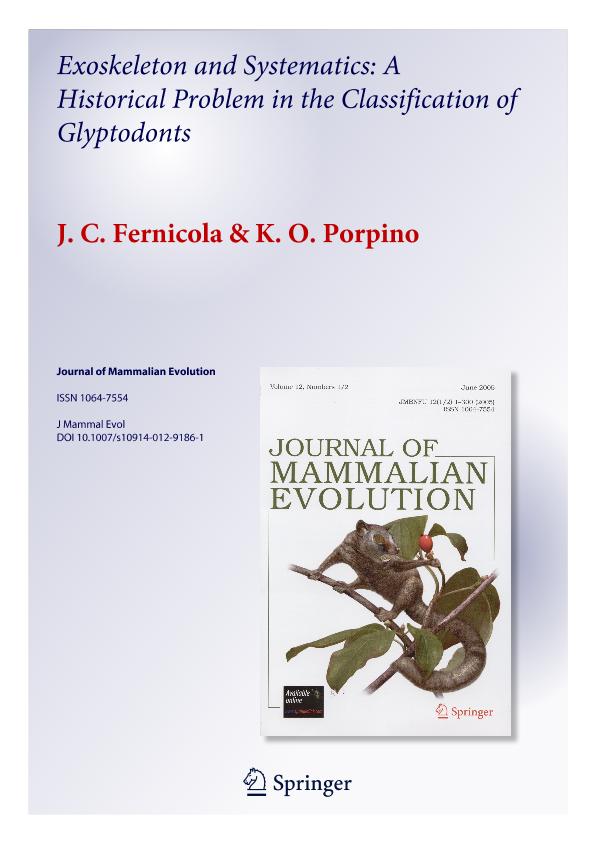Mostrar el registro sencillo del ítem
dc.contributor.author
Fernicola, Juan Carlos

dc.contributor.author
Porpino, Kleberson de O.

dc.date.available
2020-02-18T15:34:20Z
dc.date.issued
2012-09
dc.identifier.citation
Fernicola, Juan Carlos; Porpino, Kleberson de O.; Exoskeleton and Systematics: A Historical Problem in the Classification of Glyptodonts; Springer; Journal of Mammalian Evolution; 19; 3; 9-2012; 171-183
dc.identifier.issn
1064-7554
dc.identifier.uri
http://hdl.handle.net/11336/97886
dc.description.abstract
The glyptodonts (Mammalia: Cingulata) are characterized by an exoskeleton comprising most notably an armored tail and an immobile dorsal carapace formed by a large number of osteoderms. In 1889, Florentino Ameghino published the first phylogenetic scenario for the glyptodonts, based on the sequential application of two transformation series related to the morphology of the tail armor and carapace osteoderms. From the early to mid 1900s, several authors used Ameghino's transformation series subordinated to a model of evolution in which derived glyptodont groups had arisen independently from separate pre-middle Miocene ancestors. This approach, in which the morphological states of Ameghino's series were considered analogous rather than homologous, provided different phylogenetic scenarios and the paraphyletic classification still in use. Two recent cladistic analyses based on cranial and postcranial (including caudal tube) characters support the monophyly of glyptodonts and suggest novel intra-clade relationships. However, neither analysis included the classic osteoderm characters used by earlier authors. Therefore, we propose new osteoderm and carapace characters and evaluate their performance in a new cladistic analysis. We found that: a) some osteoderm characters used by earlier authors to support ancestor-descendent hypotheses are in fact fully homoplastic autapomorphies (e. g., multiplication of the number of rows of peripheral figures); b) characters previously believed to have originated independently in several groups (e. g., presence of caudal tube) are synapomorphies at a wider hierarchical level; c) some ancestor-descendant pre-cladistic hypotheses are incompatible with the topology and synapomorphy distribution obtained; and d) there is no reason to favor exoskeletal characters in glyptodont systematics.
dc.format
application/pdf
dc.language.iso
eng
dc.publisher
Springer

dc.rights
info:eu-repo/semantics/openAccess
dc.rights.uri
https://creativecommons.org/licenses/by-nc-sa/2.5/ar/
dc.subject
CAUDAL TUBE
dc.subject
CLASSIFICATION
dc.subject
GLYPTODONTS
dc.subject
OSTEODERMS
dc.subject
PHYLOGENY
dc.subject.classification
Paleontología

dc.subject.classification
Ciencias de la Tierra y relacionadas con el Medio Ambiente

dc.subject.classification
CIENCIAS NATURALES Y EXACTAS

dc.title
Exoskeleton and Systematics: A Historical Problem in the Classification of Glyptodonts
dc.type
info:eu-repo/semantics/article
dc.type
info:ar-repo/semantics/artículo
dc.type
info:eu-repo/semantics/publishedVersion
dc.date.updated
2020-02-07T13:40:25Z
dc.journal.volume
19
dc.journal.number
3
dc.journal.pagination
171-183
dc.journal.pais
Alemania

dc.journal.ciudad
Berlin
dc.description.fil
Fil: Fernicola, Juan Carlos. Consejo Nacional de Investigaciones Científicas y Técnicas. Oficina de Coordinación Administrativa Parque Centenario. Museo Argentino de Ciencias Naturales “Bernardino Rivadavia”; Argentina. Universidad Nacional de Luján. Departamento de Ciencias Básicas; Argentina
dc.description.fil
Fil: Porpino, Kleberson de O.. Universidade Federal do Rio Grande do Norte; Brasil
dc.journal.title
Journal of Mammalian Evolution

dc.relation.alternativeid
info:eu-repo/semantics/altIdentifier/url/https://link.springer.com/article/10.1007/s10914-012-9186-1
dc.relation.alternativeid
info:eu-repo/semantics/altIdentifier/doi/http://dx.doi.org/10.1007/s10914-012-9186-1
Archivos asociados
